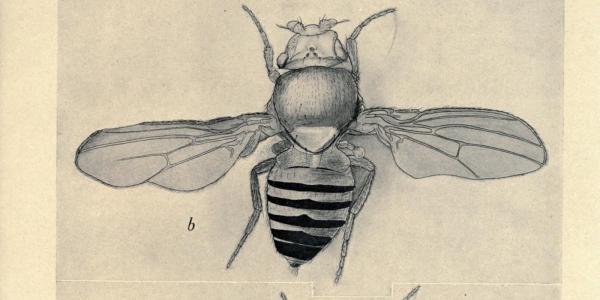Merrin Foltz investigates fruit fly genes related to mating patterns and pheromone detection.
Sophomore Merrin Foltz quickly found her place in the scientific research community at Washington University last year as a first-year student. As an undergraduate researcher in the Ben-Shahar Lab, Foltz investigates the pheromone-sensing system in Drosophila melanogaster, or the common fruit fly.
Foltz first encountered Drosophila melanogaster as part of a high school collaborative research project with Stanford University. This class was crucial in developing an understanding how to apply scientific methodologies and conduct meaningful studies. “It was just a very good opportunity knowing that I wanted to go into biology,” she said. “It gave me a great look into what research entailed.”
At first, Foltz didn’t understand why research on such simple organisms piqued people’s interest, but she later realized how fruit flies uniquely contribute to the field of neuroscience.

“It is a really unique experience to work on flies, versus mice or other organisms, because you are able to do things with flies that you can’t do otherwise. This is especially true when it comes to time. Flies have such a short life span, so the gestation process moves faster, and therefore, you have a greater population to study in a shorter amount of time,” Foltz explained.
In her high school project, Foltz had the opportunity to collaborate with a lab working on a line of flies that have had artificial DNA introduced to their genetic material. The primary goal of this research was to try and insert a genetic encoding element (insert a P-element) randomly into fly genomes with the hope that it would link to the sequence of DNA needed to turn a gene on and off (promoter) and consequently, appear in the expression pattern of that gene. While there was no specific gene in the genome that had to be linked, Foltz and her lab specifically targeted genes that could lead to further understanding diabetes.
Despite many labs not accepting first-year students from the Class of 2024 because of the pandemic, Foltz earned an undergraduate research opportunity in the lab of Yehuda Ben-Shahar, professor of biology, where she worked under the mentorship of postdoctoral researcher Nicole Leitner. The Ben-Shahar Lab is one of the few invertebrate labs on campus, and they focus their studies on molecular and behavioral biology of different insects, specifically, the fruit fly.
Leitner’s research is based on the neurodevelopment of pheromone-sensing neurons in the legs and wings of the fly. In particular, Leitner is interested in studying why these neurons cross the midline of the nervous system and connect to targets on the opposite side in males, while in females they remain on the side from which they originated. How does this sex-specific occurrence make sense? This is still mysterious, but Foltz’s research on the function of these neurons, which are important for mating behaviors, might help to provide some answers.
Foltz’s research, which is a subset of Leitner’s, explores how this midline crossing could be an important factor in understanding mating tendencies. Foltz had the opportunity to learn how to use microscopic picturing to get a closer look at the DNA. Her goal has been to track the overlapping of fluorescent colors in the picture. Overlap of fluorescent expression indicates that the cell expresses ppk23, a marker of Foltz’s interest. Learning to use the microscope furthered her understanding of fly DNA, but because of the fly’s size, it tends be a tedious process. Working with organisms this small requires patience, and this continues to hold true as Foltz begins to learn how to dissect the miniscule creatures.
When asked the application and furtherment of her research, Foltz replied that although her findings seem niche and particular, they provide a great foundation for further research.
“This information could be used for anyone studying mating rituals or studying midline crossing, and neuronal pathfinding, or how neurons know where to go. Even though it is really specific, it can be applicable to many other research projects concerning fly mating, reproduction, or sex variation,” she said. “So going forward, I want to continue learning more about the characterizations of the neurons and more about their midline crossing tendencies.”
The most important results of Foltz’s research come in discovering that the ppk23-expressing neurons are a heterogeneous population: something not previously known. This also lends to the idea that although the neurons are characterized by the same ion channel, there still seems to be a division of labor between those that populate the legs versus the wings. Her research will continue to explore this specific neuron and, by investigating the expression of many different markers, hopefully discover how it contributes to mating.
“We know all of the neurons that cross the midline express ppk23, but we still don’t know if all ppk23-expressing neurons pass the midline,” Foltz said.
Foltz pursues the answer through meticulous brain dissections. The fasinating thing about the ppk23-expressing neurons, she believes, is that we know so little about them despite their very unique function. Looking down the road, Foltz sees herself further trying to explain the environment and conditions of these neurons and how they appear in fruit flies.





